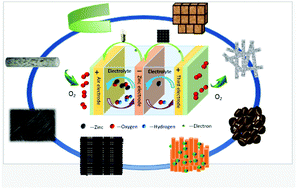Recent advances in air electrodes for Zn–air batteries: electrocatalysis and structural design
Abstract
Zn–air batteries have attracted significant attention because of their high energy density, environmental friendliness, safety, and low cost. The air cathode of is one of the most expensive cell components and a key factor in determining the performance of Zn–air batteries. As a fuel, O2 availability to the air cathode is determined by the level of both its dissolution and diffusion in an electrolyte, whereby electrocatalysis happens in the three-phase interface where the catalyst, electrolyte, and O2 meet. Maximizing the performance of air cathodes by rational design of the catalyst structure is of significant importance. To date, various electrocatalysts, including heteroatom-doped carbon, transition metal nitrides/oxides/sulfides, and perovskite oxides, have been developed with outstanding oxygen reduction reaction and oxygen evolution activity. More and more researchers are trying to apply electrocatalysts into Zn–air battery prototypes. The aim of this review is to afford a better understanding of air cathodes and provide guidelines to the researchers for the design and construction of high-performance, easy-to-use cathodes for metal–air batteries.



 Please wait while we load your content...
Please wait while we load your content...